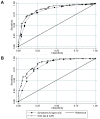Improving the clinical diagnosis of influenza--a comparative analysis of new influenza A (H1N1) cases
- PMID: 20041115
- PMCID: PMC2795196
- DOI: 10.1371/journal.pone.0008453
Improving the clinical diagnosis of influenza--a comparative analysis of new influenza A (H1N1) cases
Abstract
Background: The presentation of new influenza A(H1N1) is broad and evolving as it continues to affect different geographic locations and populations. To improve the accuracy of predicting influenza infection in an outpatient setting, we undertook a comparative analysis of H1N1(2009), seasonal influenza, and persons with acute respiratory illness (ARI) in an outpatient setting.
Methodology/principal findings: Comparative analyses of one hundred non-matched cases each of PCR confirmed H1N1(2009), seasonal influenza, and ARI cases. Multivariate analysis was performed to look for predictors of influenza infection. Receiver operating characteristic curves were constructed for various combinations of clinical and laboratory case definitions. The initial clinical and laboratory features of H1N1(2009) and seasonal influenza were similar. Among ARI cases, fever, cough, headache, rhinorrhea, the absence of leukocytosis, and a normal chest radiograph positively predict for both PCR-confirmed H1N1-2009 and seasonal influenza infection. The sensitivity and specificity of current WHO and CDC influenza-like illness (ILI) criteria were modest in predicting influenza infection. However, the combination of WHO ILI criteria with the absence of leukocytosis greatly improved the accuracy of diagnosing H1N1(2009) and seasonal influenza (positive LR of 7.8 (95%CI 3.5-17.5) and 9.2 (95%CI 4.1-20.3) respectively).
Conclusions/significance: The clinical presentation of H1N1(2009) infection is largely indistinguishable from that of seasonal influenza. Among patients with acute respiratory illness, features such as a temperature greater than 38 degrees C, rhinorrhea, a normal chest radiograph, and the absence of leukocytosis or significant gastrointestinal symptoms were all positively associated with H1N1(2009) and seasonal influenza infection. An enhanced ILI criteria that combines both a symptom complex with the absence of leukocytosis on testing can improve the accuracy of predicting both seasonal and H1N1-2009 influenza infection.
Conflict of interest statement
Figures


References
-
- World Health Organization. Human infection with new influenza A (H1N1) virus: clinical observations from Mexico and other affected countries, May 2009. Wkly Epidemiol Rec. 2009;84:185–189. - PubMed
-
- Dawood FS, Jain S, Finelli L, Shaw MW, Lindstrom S, et al. Emergence of a novel swine-origin influenza A (H1N1) virus in humans. N Engl J Med. 2009;360:2605–2615. - PubMed
-
- Ong AK, Hayden FG. John F. Enders lecture 2006: antivirals for influenza. J Infect Dis. 2007;196:181–190. - PubMed
-
- Call SA, Vollenweider MA, Hornung CA, Simel DL, McKinney WP. Does this patient have influenza? JAMA. 2005;293:987–997. - PubMed
-
- Ministry of Health. MOH Circular 34/2009: Public health measures for public sector hospitals & national centres: Swine Influenza A (H1N1) Singapore: MOH; 2009.
Publication types
MeSH terms
LinkOut - more resources
Full Text Sources
Medical

